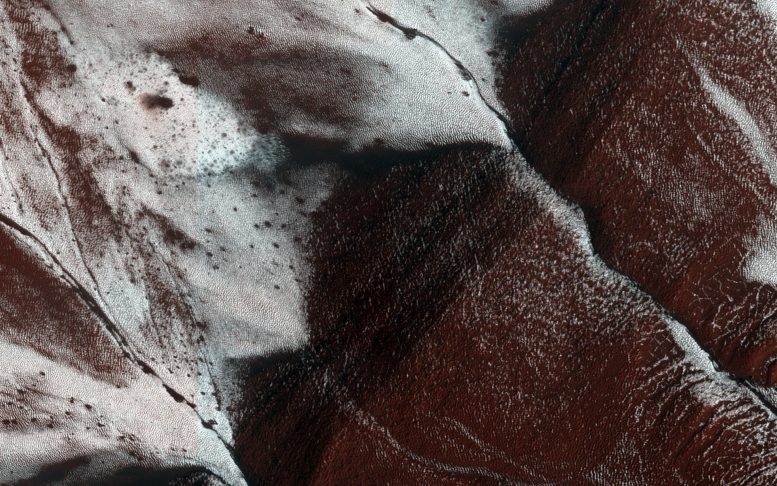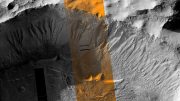
The image reveals frosted gullies on a south-facing slope within a crater on Mars. Credit: NASA/JPL-Caltech/University of Arizona
This newly released NASA image shows an area on the surface of Mars (approximately 1.5 by 3 kilometers or 0.9 by 1.9 miles in size) with frosted gullies on a south-facing slope within a crater.
At this time of year, only south-facing slopes retain the frost, while the north-facing slopes have melted. Gullies are not the only active geologic process going on here. A small crater is visible at the bottom of the slope.
The image was acquired on November 30, 2014, by the High Resolution Imaging Science Experiment (HiRISE) camera, one of six instruments on NASA’s Mars Reconnaissance Orbiter. The University of Arizona, Tucson, operates HiRISE, which was built by Ball Aerospace & Technologies Corp., Boulder, Colorado. NASA’s Jet Propulsion Laboratory, a division of the California Institute of Technology in Pasadena, manages the Mars Reconnaissance Orbiter Project for NASA’s Science Mission Directorate, Washington.









Is the frost water or carbon dioxide?
96% of the Martian atmosphere is Carbon Dioxide, and 2% Argon and 2% Nitrogen with trace amounts of Oxygen and Carbon Monoxide which both are in the .0 figures. Any frost would (i suspect) be also in those figures per square mile. There is a lack of H20 on Mars (water) so no the frost is mainly Carbon Dioxide. Merry Christmas.
I hope that Frosty the Martian has a compass to extend his lifespan. Pole-facing slopes have orientations such that they do not receive as much sunlight as equator-facing slope, which receive the most sunlight. If you live where it snows regularly you should be able to relate to this. Have you noticed that it takes a lot longer for snow and ice to melt on the north side of structures like apartments and homes (in the norther hemispheres). In the norther hemisphere, pole-facing would be north facing, but, in the souther hemisphere, pole-facing would be south facing. The same deal on Mars.